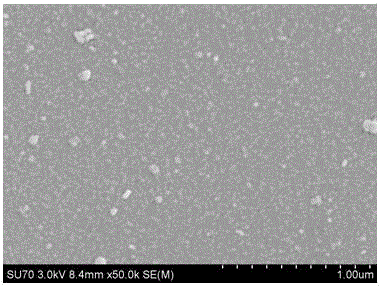Method for preparing titanium dioxide nano-film on surface of expanded polytetrafluoroethylene
The technology of polytetrafluoroethylene and polytetrafluoroethylene plate is applied in the field of preparing titanium dioxide nano-film on the surface of expanded polytetrafluoroethylene, which can solve the problems of complicated operation process, high cost, weak bonding of tetrafluoroethylene plate, etc. To achieve the effect of simple preparation process, convenient operation, good biocompatibility and light responsiveness
- Summary
- Abstract
- Description
- Claims
- Application Information
AI Technical Summary
Problems solved by technology
Method used
Image
Examples
Embodiment 1
[0017] (1) Soak the expanded polytetrafluoroethylene substrate in absolute ethanol, ultrasonically clean it for 20 minutes, then take out the substrate and dry it at 60°C, then soak it in 3mol / L NaOH solution for 10 hours, and dry it naturally;
[0018] (2) Introduce oxygen into the plasma reactor, place the cleaned and dried expanded polytetrafluoroethylene substrate at a position 10cm away from the plasma discharge area, and treat it for 10s;
[0019] (3) Mix tetrabutyl titanate and absolute ethanol at a volume ratio of 1:1 and stir evenly to obtain A solution;
[0020] (4) On the expanded polytetrafluoroethylene substrate treated in step 2), 20ul of solution A was added dropwise, spin-coated at a speed of 7000r / min for 30s, and dried at 60°C to obtain a tetrabutyl titanate film;
[0021] (5) The tetrabutyl titanate film prepared in step 4) was immersed in a hydrothermal tank filled with deionized water, and hydrothermally treated at 140°C for 2 hours to obtain a titanium di...
Embodiment 2
[0024] (1) Soak the expanded polytetrafluoroethylene substrate in absolute ethanol, ultrasonically clean it for 20 minutes, then take out the substrate and dry it at 60°C, then soak it in 1mol / L NaOH solution for 8 hours, and let it dry naturally;
[0025] (2) Introduce oxygen into the plasma reactor, place the cleaned and dried expanded polytetrafluoroethylene substrate at a position 15cm away from the plasma discharge area, and treat it for 20s;
[0026] (3) Mix tetrabutyl titanate and absolute ethanol at a volume ratio of 1:2 and stir evenly to obtain A solution;
[0027] (4) On the expanded polytetrafluoroethylene substrate treated in step 2), 22ul of solution A was added dropwise, spin-coated at a speed of 7000r / min for 32s, and dried at 60°C to obtain a tetrabutyl titanate film;
[0028] (5) The tetrabutyl titanate film prepared in step 4) was immersed in a hydrothermal tank filled with deionized water, and hydrothermally treated at 140°C for 2 hours to obtain a titanium...
Embodiment 3
[0031] (1) Soak the expanded polytetrafluoroethylene substrate in absolute ethanol, ultrasonically clean it for 20 minutes, then take out the substrate and dry it at 60°C, then soak it in 3mol / L NaOH solution for 10 hours, and dry it naturally;
[0032] (2) Introduce oxygen into the plasma reactor, place the cleaned and dried expanded polytetrafluoroethylene substrate at a position 20cm away from the plasma discharge area, and treat it for 30s;
[0033] (3) Mix tetrabutyl titanate and absolute ethanol at a volume ratio of 1:3 and stir evenly to obtain A solution;
[0034] (4) On the expanded polytetrafluoroethylene substrate treated in step 2), 24ul of solution A was added dropwise, spin-coated at a speed of 7000r / min for 34s, and dried at 60°C to obtain a tetrabutyl titanate film;
[0035] (5) The tetrabutyl titanate film prepared in step 4) was immersed in a hydrothermal tank filled with deionized water, and hydrothermally treated at 140°C for 3 hours to obtain a titanium di...
PUM
 Login to View More
Login to View More Abstract
Description
Claims
Application Information
 Login to View More
Login to View More - R&D
- Intellectual Property
- Life Sciences
- Materials
- Tech Scout
- Unparalleled Data Quality
- Higher Quality Content
- 60% Fewer Hallucinations
Browse by: Latest US Patents, China's latest patents, Technical Efficacy Thesaurus, Application Domain, Technology Topic, Popular Technical Reports.
© 2025 PatSnap. All rights reserved.Legal|Privacy policy|Modern Slavery Act Transparency Statement|Sitemap|About US| Contact US: help@patsnap.com

